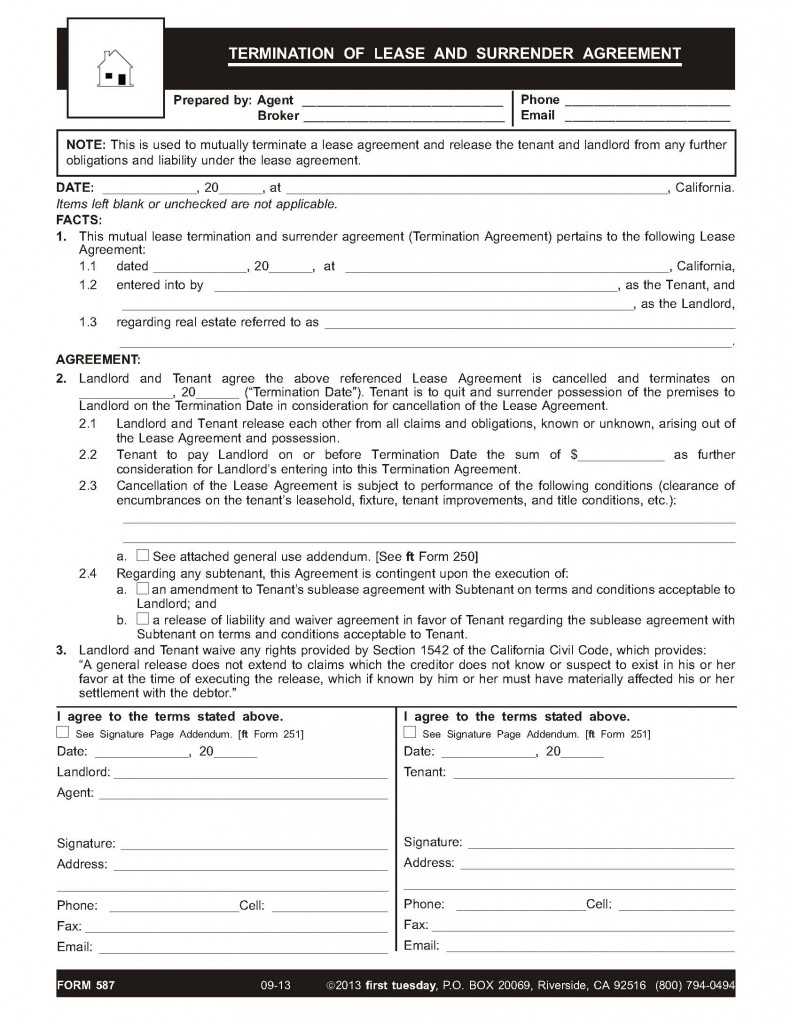Form-of-the-week: Termination of Lease and Surrender Agreement – Form 587
Consider a tenant who breaches a nonresidential lease agreement before the lease expires and vacates the premises without the landlord’s service of a three-day notice to quit on the tenant. The landlord may respond to possession in one of four ways:
- terminate the tenant’s right of possession and cancel the lease agreement by a surrender, then relet the premises to others or occupy the premises as the owner [See first tuesday Form 587];
- terminate the tenant’s right of possession using a three-day notice containing a declaration of forfeiture (or a notice of abandonment), then take possession and relet the premises to mitigate losses before making a demand for payment of future rents [See first tuesday Form 575 and 581];
- take possession of the premises and relet it on the tenant’s behalf, then collect any monthly losses from the tenant; or
- enforce any tenant-mitigation provision in the lease agreement, leaving the tenant in possession to relet the premises to mitigate the tenant’s losses.
Only ownership of a real estate interest, such as a leasehold interest, and personal property may be forfeited. However, a contract, such as a lease agreement, is not property. A contract is evidence of rights and obligations. Thus, it may be cancelled, but it cannot be the subject of forfeiture.
A surrender occurs when:
- a tenant breaches a lease or rental agreement and vacates or intends to vacate the premises; and
- the landlord agrees to accept a return of possession from the tenant in exchange for cancelling the lease agreement.
A surrender occurs due to the cancellation of the lease agreement by either:
- mutual consent of the landlord and the tenant [Calif. Civil Code §1933(2)]; or
- operation of law, implied due to the conduct of the landlord.
For a landlord to avoid adverse legal consequences when a tenant prematurely vacates, lease agreements contain a remedies provision stating a surrender can occur only if the tenant enters into a written cancellation and waiver agreement. [See first tuesday Form 552-3 §20.1]
first tuesday’s Termination of Lease and Surrender Agreement provides the writing used to mutually terminate a lease agreement and release the tenant and landlord from any further obligations and liability under the lease agreement. [See first tuesday Form 587]
This lease termination and surrender agreement provisions include:
- the termination date on which the tenant is to quit and surrender possession of the premises to the landlord in consideration for cancellation of the lease agreement [See first tuesday Form 587 §2];
- a release between the landlord and tenant from all claims and obligations, known or unknown, arising out of the lease agreement and possession [See first tuesday Form 587 §2.1];
- any monetary consideration to be paid by the tenant to the landlord for entering into the termination agreement [See first tuesday Form 587 §2.2];
- a description of any conditions to be performed prior to cancellation, which may include any payment the landlord will make to the tenant, such as a return of deposit, prepaid rent or settlement money on a dispute [See first tuesday Form 587 §2.3]; and
conditions pertaining to a subtenant, if any, that needs to be arranged and agreed to. [See first tuesday Form 587 §2.4]



















If a residential tenant does not have a lease. If he signs a surrender of lease agreement is it beneficial to landlord. Even though the tenant ends up not vacating the premises. Can the police take out any tenants there once landlord has a surrender of lease agreement or it still needs to go through the court system and take 6 months?